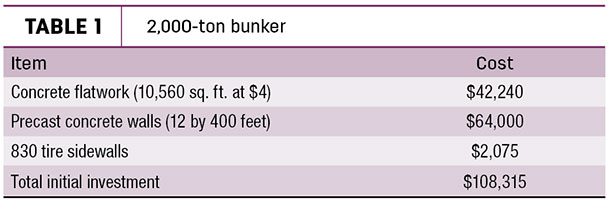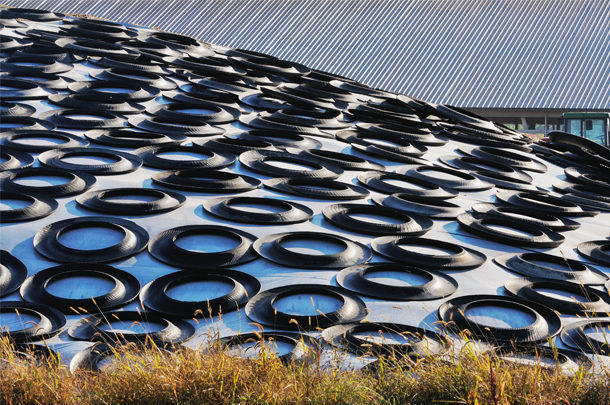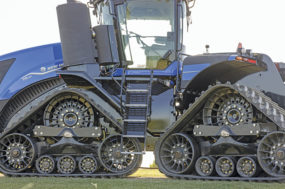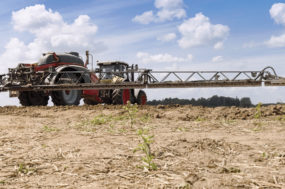For any specific situation, the ultimate solution could be different than the next. For the purpose of this article, however, I’ll make some generic comparisons.
For the first comparison, we will compare building storage for 2,000 tons of silage as a drive-over pile and as a two-walled bunker silo. We will use 6-inch-thick concrete as our base material and assume a cost of $4 per square foot.
Bunker costs
We will need a rectangular pad of concrete to hold the silage that is 44 by 200 feet. We add two 44-by-20-foot aprons at both ends of the bunker. We will need two walls for our bunker that are each 12 feet tall and 200 feet long at $160 per foot.
We will also need 830 truck tire sidewalls for covering, and it will cost us $1,296 each year to buy enough Silostop oxygen-barrier and black-and-white plastic to cover both the sidewalls (black-and-white only) and the silage (both Silostop and black-and-white).
To summarize our 2,000-ton bunker, see Table 1.
 Borrowed at 4 percent interest and amortized over 15 years, the annual payment on this investment would be $9,743. Adding in the annual plastic cost of $1,296 gives a total annual cost of $11,039 for 2,000 tons of silage or $5.52 per ton per year.
Borrowed at 4 percent interest and amortized over 15 years, the annual payment on this investment would be $9,743. Adding in the annual plastic cost of $1,296 gives a total annual cost of $11,039 for 2,000 tons of silage or $5.52 per ton per year.
Pile costs
Now let’s put up the same 2,000 tons as a drive-over pile. We will now need a rectangular pad of concrete that’s 80 by 200 feet. We add 15-by-80-foot aprons at both ends and 15-by-230-foot aprons on both sides of the pile.
We don’t need any walls, but we do need 1,880 tires for the pile, and the plastic to cover the pile will cost us $2,384 each year.
To summarize our 2,000-ton drive-over pile, see Table 2.
 Borrowed at 4 percent interest and amortized over 15 years, the annual payment on this investment would be $9,525. Adding in the annual plastic cost of $2,384 gives a total annual cost of $11,909 for 2,000 tons of silage or $5.95 per ton per year.
Borrowed at 4 percent interest and amortized over 15 years, the annual payment on this investment would be $9,525. Adding in the annual plastic cost of $2,384 gives a total annual cost of $11,909 for 2,000 tons of silage or $5.95 per ton per year.
Given these assumptions, you can store silage in a two-walled bunker at a 7 percent discount to storing it in a drive-over pile.
Side-by side bunkers add efficiency
The savings for the bunkers increase when comparing a two-unit system. Using the same cost architecture, the cost to store 4,000 tons of silage in two bunkers is $4.77 per ton per year and $5.45 per ton per year in two 2,000-ton piles.
That’s a 9 percent discount in favor of the bunkers, mainly due to sharing one of the walls, which is one of the most expensive components in the bunker system. (We only need three walls for two side-by-side bunkers.)
Size matters
Now let’s take our individual storage structures and increase their size. That way, we can take advantage of more of the free storage area above the concrete.
The cost to store 10,000 tons of silage in one 100-by-250-foot bunker is $2.34 per ton per year, which is a 13 percent discount to the $2.67 per ton per year that it costs to store 10,000 tons of silage in one large drive-over pile.
Finally, comparing two adjacent large storage structures yields the lowest costs. The cost to store 20,000 tons of silage in two 10,000-ton bunkers is $2.10 per ton per year – a 19 percent discount to the $2.59 per ton per year that it would cost for two 10,000-ton piles.
Other considerations
If cost were the only factor in picking a storage structure, bunkers would be the obvious choice. The added cost of the walls is more than made up for by limiting the flat space needed for storage. The advantage of bunkers only grows with more units and more tons.
Storage costs for either type of unit decrease with larger sizes because they take advantage of the free space above the structure that would otherwise be occupied by air.
However, you need to also consider some other factors. Piles may be safer and easier to pack, depending on their slopes. Easier packing can lead to less spoilage in the silage, especially that spoilage we often see in the “shoulders” of bunkers.
Piles also provide unlimited flexibility for changing dimensions to accommodate future needs. Bunker walls are much less accommodating.
Even though bunker walls typically show an economic advantage, drive-over piles might be the best answer in a specific situation. ![]()
—Excerpts from Vita Plus Forage Foundations E-news, March 2016
PHOTO: Bunker walls may have an economic advantage, but drive-over piles might be the best answer in a specific situation. Photo by Thinkstock.

-
Randall Greenfield
- Nutritionist
- Vita Plus Corporation
- Email Randall Greenfield












